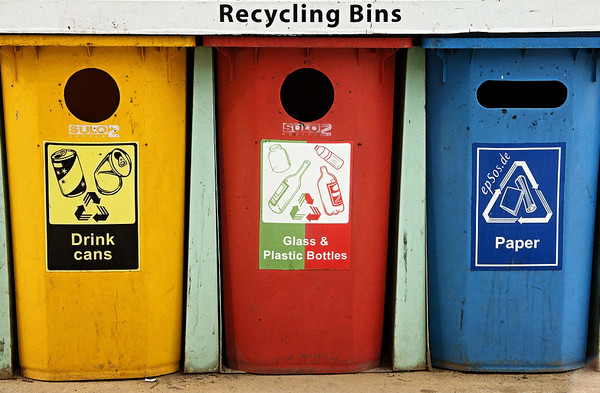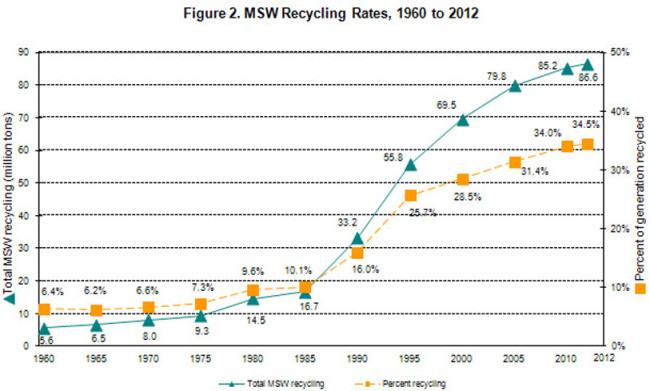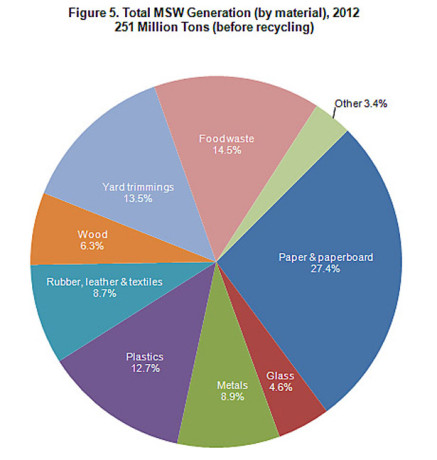Each day we create an excess of waste that builds up in landfills, in our oceans, and in our bodies. Here is the story of our waste.
We create a ton of waste everyday, there is no denying that fact. This is especially true if you live in the United States– we would need FOUR planets if everyone on the planet consumed the same amount of resources as Americans. We live in a society that puts a lot of value in consumerism and immediacy– we want WHAT we want, WHENEVER we want it. This insistence on having everything accessible, cheap, and NOW has put a lot of pressure on our natural systems and creates an excessive amount of waste.
How much waste? In the US, residents create about 4.4 pounds of trash per person per day. Our physical trash is made of paper, plastic, food and metals. When it gets tossed into the trash bin, where does it go? As you might imagine, there is no magical ‘away’ and our trash eventually comes back to haunt us. Landfills leak toxins into groundwater, rubbish builds up in the middle of the ocean, and plastics leech chemicals back into the environment.
How do we deal with our garbage?
As we wrote about in in this post about how our trash affects the whole planet, our trash never disappears.
Most municipalities have few ways to deal with trash, and often it’s a landfill on the outskirts of town. All modern landfills have linings to deal with rainwater collection and leeching, but older landfills may not have a liner, or the liner may be cracked, which means that all the chemicals, hazardous waste, mercury, and other toxins leak through the liner and into the ground. Landfills also leak toxins into the air, most notably methane, a greenhouse gas much more potent than carbon dioxide.

Some municipalities burn their trash for energy. This is the common practice on Oahu, an island in the American state of Hawaii. The city’s waste management office has a contract with the electric utility to provide a set amount of waste to the incinerator to keep the trash burning to fuel the electricity needs of the island. Though this process is controlled by scrubbers and other high-tech ways to keep the gases and fumes out of the air at the incinerator, other places burn their trash regularly without such regulations, leading to release of carbon dioxide and a toxic stew of chemicals from charred plastics and electronics. And though the EPA has created laws to regulate incinerators, new facilities are still allowed to release chemicals into the air. At a proposed incinerator in Baltimore, rulings allow 240 pounds of mercury and 1,000 pounds of lead annually. Both mercury and lead are potent neurotoxins that bioaccumulate in the body over time.
What about recycling?
Recycling is an option in most municipalities, and it does have the potential to divert a significant amount of trash from landfills. But after big pushes in the 1990s, recycling efforts have not gained much traction in recent years, with the exception of larger, super progressive cities like San Francisco and Vancouver, Canada. Both of these cities recycle almost all trash items and food waste in city-wide programs.

But we’re kinda failing at this. Plastics production is INCREASING, but recycling efforts are not. According to Worldwatch Institute:
“For more than 50 years, global production of plastic has continued to rise. Some 299 million tons of plastics were produced in 2013, representing a 4 percent increase over 2012. Recovery and recycling, however, remain insufficient, and millions of tons of plastics end up in landfills and oceans each year.”
Why do recycling efforts fall short for most cities? Most cities that offer recycling do so for aluminum, paper, glass, various numbers of plastics, newspaper, magazines and more, but each city’s different in what they will accept into recycling programs, and often it’s very confusing for residents. In the UK a report said that residents feel ‘green fatigue‘– a surge of indifference or disinterest in learning more about green initiatives. Some residents don’t care to read the recycling numbers of plastic on their item and just find it easier to toss it into the trash.
Research from 2012 shows that Sweden, Austria and Germany lead worldwide recycling efforts; in North America, San Francisco and Vancouver are considered the greenest cities. More recent research gives Washington top honors for recycling, but even at the highest ranking, it is still only recycling about 49% of its trash; by contrast, the national average is only 34.5%, with parts of Long Island coming in as low as 20% for recent years. The EPA graph below shows that waste rates are increasing rapidly, while recycling efforts are not keeping pace. But it’s not really clear that recycling is the best option for the environment after all. But it’s arguable whether or not recycling is really the solution.
However, it’s important to look at reuse options for trash with potentially toxic components like batteries and electronics, which can be recycled at participating retail locations. You can recycle Brita filters, and can donate your clothes and eyeglasses, giving them new life. But recycling is not going to save us.
What makes our garbage so trashy?
What does our trash really look like, and what are the solutions to reduce it? This chart from the EPA (data from 2012) shows what constitutes our trash and shows us some great room for making change:
This chart explains many things quickly: which items create the bulk of our trash, but also huge opportunities for us to change our habits.
Yard waste and food waste are easy starting points for waste diversion. Our food supply chain leaves farmers with excess, unsaleable product which rots in the fields, and grocery stores have overstocked displays and requirement for perfect produce (meaning a perfectly edible but imperfect looking tomato may simply get chucked), leading to an excess of waste before it even reaches our homes. And once it gets there, we throw away 30-50% of our total food purchases. Food waste and yard waste are the easiest of these waste options to divert, and one that requires minimal effort at the personal or municipal level. Food waste efforts can include:
- Backyard composting: If you have even a small bit of yard space, you can create a compost pile to reduce your overall waste output AND create beneficial amendments to your soil. Composting has a dirty reputaion, but there are a bunch of gadgets and tools to help make it easier than ever. If you’re an apartment dweller, there are options for small spaces like worm bins and bokashi buckets.
- Animal feed: Some cities have feed programs that take food waste and give it to pig farms. While industrial animal agriculture is a large waste problem of its own, small animal farms may benefit from the free food supply for their animals.
- Industrial composting: Some municipalities have industrial composting facilities that can handle large items like Christmas trees, park waste and biocompostable products, which need specific conditions to actually break down.
- Food donations: Much of the food waste in our system is actually at the supply chain level. The NRDC estimated that just 15% of all wasted food would be enough to feed more than 25 million Americans every year through food bank and other donation programs.
Paper and paperboard are the next big contributor, another product that is easily reduce-able. But relying on recycling is not the best option for paper, as often chemicals are used the the process and can create its own negative environmental impact. According to the Forbes, for “newspaper, dimensional lumber, and medium-density fiberboard–the net greenhouse gas emissions reductions enabled by recycling are actually greater than they would be if the waste source was simply reduced.” And paper is not infinitely recyclable, as often thought. Higher quality papers can offer some benefit when recycled but other lower quality paper might be best NOT recycled.
But it’s arguable that plastics are the biggest problem here. The best way to avoid getting plastics in our waste supply is to avoid them as much as possible as a consumer. As much as possible, choose non-plastic options. This includes simple things like bringing your lunch, carrying a reusable bag, and sipping from a stainless steel or glass water bottle. But plastic is EVERYWHERE in our everyday life, and it’s not good for us.
Despite claims of safety from the chemical companies about the safety of petrochemical-based plastics, very few of the the ingredients in plastic have ever been tested. Not only does plastic build up in our landfills at 12% of our waste, it’s also way more dangerous than paper or food waste. The American Chemistry Council, the mouthpiece for chemical and plastics manufacturing, has been caught lying about chemicals, and was also caught funding a false ‘study’ showing that reusable bags are dangerous for consumers (to encourage us to use more plastic bags, of course).
How powerful is the ‘Big Plastic’ lobby group? Alternet says,
“The industry that produces plastic, largely represented by the American Chemistry Council (ACC), has an annual budget of over $120 million to protect its interests. But as the plague of plastic that wreaks havoc on our environment slowly gains the attention of policymakers, concerned citizens and the media, the makers of plastic resins and the companies that package their products have become increasingly aggressive about defending their respective bottom lines.”
And worst of all is that plastics are not really that recyclable, which is why recycling is not really the best option. It’s a falsehood that plastics can be recycled indefinitely. In fact, most plastics can only be recycled once, and those plastics are usually downgraded into other items like fleece (thanks, Patagonia!) and plastic lumber, which are not recyclable at that stage. Plastics can be melted to be used as fuel, and a report from Colombia says that this melting plastics for fuel or burning for energy is actually a relatively efficient source of energy, but it doesn’t discount the issue of all the chemicals finding their way into the environment. So we can’t rely on recycling to reduce our plastic impact, we have to stop it– and all other waste– at the source… which is us and our shopping habits.
Changing the culture of consumerism
It might seem hard to live a waste-free or a waste-reduced life, but it’s definitely possible and is incredibly rewarding. Here’s our best tips for using less waste overall in our lifestyle
- Learn more about how our materials economy affects our planet: watch the Story of Stuff, the Story of Bottled Water, and read our post here about how our trash is everywhere.
- Learn about the dangers of plastics and chemicals, and find out how to avoid them.
- Find resources for living Zero Waste. Take small steps and eventually dwindle your need for virgin resources, whether it’s clothing, plastics and more. Bring your own silverware sets or chopsticks, carry a water bottle and coffee mug and try to bring bowls or plates to picnics, barbeques and take-out restaurants where there is likely to be plastic take-out containers.
- Look into your municipal waste options. Do you have city-wide composting for food or green waste? Can you recycle your magazines and newspapers? What happens to the aluminum in your city?
- What steps can take at home to reduce your food waste output? If you have to pay by the pound for waste disposal, reducing your food waste with a composting plan can save you money (and give you compost for your garden too)
- Learn to shop with reusable bags, shop in the bulk bins, avoid processed (packaged) foods, and skip bottled waters and sodas as much as possible.




jottman
Jeff, Thanks so much for this piece. Would that EVERYONE learned this in school. Requirement for graduation! I feel so strongly about this, I started an online community and we’re all sharing ideas about what to do about the waste. And we’re now launching training to help us adults catch up with what we ‘missed’ in school. Any readers are welcomed to check us out at http://www.wehatetowaste.com
All the best,
Jacquie Ottman
Jeff McIntire-Strasburg
And let me give a “thumbs up” to Jacquie’s community… very useful!